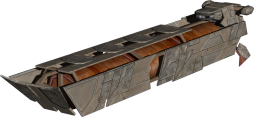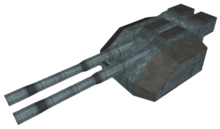07-31-2014, 02:36 AM

Diego Rodriguez stood up after the ship rematerialized. Omicron Alpha. Home of the Outcasts - his home. Beleaguered by invaders from all sides, the once proud Nacion had fallen into disrepair, with the notorious crime family, the Contari, all but a memory now, and the once stalwart guard of the Omicrons, the 101st Ghosts, reduced to but a paltry fleet of destroyers and picket vessels.
As he began to maneuver his vessel towards Malta orbit, he thought of the days to come. The reborn Contari crime syndicate, the Campania Cartel, the 'Guardia de Malta', and others would try to take hold of the now exceedingly fragile Maltese worlds. He was one of them.
The Crimson Cross, a rebirth of the original Crimson Cross c. 700 A.S., an order of Maltese warriors designed to combat the scourge of the Omicrons, the Imperio del Corsario, is the movement Diego found himself a part of. The present day Cross maintained nothing of its original grandeur, save for a 100 year old prototype Ranseur, the MNS Syracuse, and the MNS Comino, a RM-1 Outcast Destroyer-class vessel designed to support the Syracuse during the original Corsair Crusades.
100 years later, the Cross found itself reborn, although with not much more than two aging vessels, barely functioning at this point, and a host of small Outcast-manufactured snubcraft assigned to the Syracuse. Diego, a transport pilot and handyman, had been brought aboard by the Cross to see what he could do to change that.
Which brought Diego to Malta. He piloted his vessel, the Expedidor, a train manufactured by the pirates of the borderworlds, into dock at Valetta Shipyard. The Shipyard, now bustling with activity after numerous supply runs by the Junkers, was in a state of near disrepair. The sheer volume of shipments coming in each day left the workers of the shipyard completely overworked, and they were constantly losing money. Diego, an enterprising man at the best of times, decided to use that to his advantage.
Within a day of his arrival, Diego had managed to persuade the Valetta supervisors to allow the once prestigious Cross to utilize the lower scaffolding as a shipyard for the Cross' efforts. He then spent the next two weeks coordinating with local officials and his assembled technical experts to overhaul the drydock of Valetta to accompany any new vessel. The first mission was to repair the ancient Syracuse.
As he began to maneuver his vessel towards Malta orbit, he thought of the days to come. The reborn Contari crime syndicate, the Campania Cartel, the 'Guardia de Malta', and others would try to take hold of the now exceedingly fragile Maltese worlds. He was one of them.
The Crimson Cross, a rebirth of the original Crimson Cross c. 700 A.S., an order of Maltese warriors designed to combat the scourge of the Omicrons, the Imperio del Corsario, is the movement Diego found himself a part of. The present day Cross maintained nothing of its original grandeur, save for a 100 year old prototype Ranseur, the MNS Syracuse, and the MNS Comino, a RM-1 Outcast Destroyer-class vessel designed to support the Syracuse during the original Corsair Crusades.
100 years later, the Cross found itself reborn, although with not much more than two aging vessels, barely functioning at this point, and a host of small Outcast-manufactured snubcraft assigned to the Syracuse. Diego, a transport pilot and handyman, had been brought aboard by the Cross to see what he could do to change that.
Which brought Diego to Malta. He piloted his vessel, the Expedidor, a train manufactured by the pirates of the borderworlds, into dock at Valetta Shipyard. The Shipyard, now bustling with activity after numerous supply runs by the Junkers, was in a state of near disrepair. The sheer volume of shipments coming in each day left the workers of the shipyard completely overworked, and they were constantly losing money. Diego, an enterprising man at the best of times, decided to use that to his advantage.
Within a day of his arrival, Diego had managed to persuade the Valetta supervisors to allow the once prestigious Cross to utilize the lower scaffolding as a shipyard for the Cross' efforts. He then spent the next two weeks coordinating with local officials and his assembled technical experts to overhaul the drydock of Valetta to accompany any new vessel. The first mission was to repair the ancient Syracuse.
![[Image: SK33MgO.png]](http://i.imgur.com/SK33MgO.png)
The Syracuse was in a much worse shape than anyone in the Cross cared to admit. While it flew, technically speaking, it was in no shape to do so. The primary fusion drive was offline, the super-structure was failing in multiple points, and the main weapons battery was heavily damaged.
Diego had a conundrum. Valetta had resources, but only in terms of valuable scrap brought up from the Texas fields. That kind of scrap has a good many uses, in most cases being workable parts that fell off of wrecks of vessels, but there were still a lot of things you needed new, or at least used - not salvaged. As work began to repair the gargantuan Syracuse, Diego headed out on the Expedidor toward the inner worlds. Hopefully the seedier side of Sirius had survived what had struck the Outcasts, and he could get what he needed to finish the job.
Diego had a conundrum. Valetta had resources, but only in terms of valuable scrap brought up from the Texas fields. That kind of scrap has a good many uses, in most cases being workable parts that fell off of wrecks of vessels, but there were still a lot of things you needed new, or at least used - not salvaged. As work began to repair the gargantuan Syracuse, Diego headed out on the Expedidor toward the inner worlds. Hopefully the seedier side of Sirius had survived what had struck the Outcasts, and he could get what he needed to finish the job.

![[Image: 4LTQPEb.png]](http://i.imgur.com/4LTQPEb.png)
